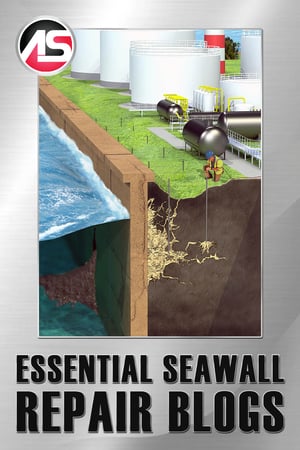
 This article features intros and links to our top 5 most popular seawall repair blogs:
This article features intros and links to our top 5 most popular seawall repair blogs:
- Stop Erosion Through Your Seawall with Polyurethane
- An In-Depth Look at Polyurethane Seawall Repair
- Residential Seawall Repair
- Signs a Seawall is in Need of Repair
- Polyurethane Foam for Seawall Repair - Technical Details
Get up to speed quickly with these blog posts. You may also want to visit the seawall repair application page for an animated explainer video, product info, and links to all seawall repair blog posts.
Stop Erosion Through Your Seawall with Polyurethane
A seawall is like a living, breathing thing: especially in the way that it is designed to function. But like all living breathing things, seawalls have a finite lifespan. For many of them, it's a mere 20 – 30 years. Depending on where you live, replacing a seawall can cost anywhere from $150 to $500 per foot. That's enough for some homeowners to choose to move instead of rebuilding their seawalls. Today however, signs of seawall distress can be solved before they get too bad through the application of polyurethane grouts to seal leaks, fill voids, and stabilize the surrounding soils. Click here to read more...
An In-Depth Look at Polyurethane Seawall Repair
In this blog post we’ll look at an innovative way to repair seawalls instead of replacing them by stopping high flow leaks, filling the voids behind concrete structures and binding loose soil with polyurethane foam. As tidal flows rise and fall, water pushes its way in through cracks, joints, and defects in seawalls. The water pushes in on incoming tides and flows out on outgoing tides. As the water flows out, it carries sand and soil with it which causes undermining of the structure. Click here to read more...
Residential Seawall Repair
If you love the ocean, then living near the water can be an ideal situation most of the time. You can enjoy scenic views of the sea, easy access to the water, and gentle ocean breezes as you sit out on your deck. But one challenge many oceanfront home owners eventually find themselves facing is leaking seawalls. You depend on seawalls to keep water on the outside and the the soil that supports your property on the inside. The seawall protecting your property is vulnerable to many degrading factors. Click here to read more...
Signs a Seawall is in Need of Repair
Salt corrosion, tidal action, currents, boat wakes, storm surges and sometimes hurricanes all deliver a constant beating on the seawall. Contrary to popular opinion, many of the forces also come from the side of the wall facing the land. Did you realize that rainfall/storm events create more hydrostatic pressure than rising and falling tides? Every time it rains or the irrigation system runs, and every time the tide goes out; all of the groundwater above the waterline needs a place to vent or equalize. Massive pressure can build up if that water is trapped, making it impossible for it to drain into the sea or storm water system. That is a recipe for disaster which can easily be avoided with proper surveillance. Let's take a look at some of the external signs a seawall is in need of repair. Click here to read more...
Polyurethane Foam for Seawall Repair - Technical Details
Repair sea walls instead of replacing them by stopping high flow leaks, filling the voids behind concrete structures and binding loose soil with AP Fill 720 & AP Fill 700 — innovative, cost effective, water activated, low viscosity, simple to use closed cell polyurethane injection resins. Click here to read more...


